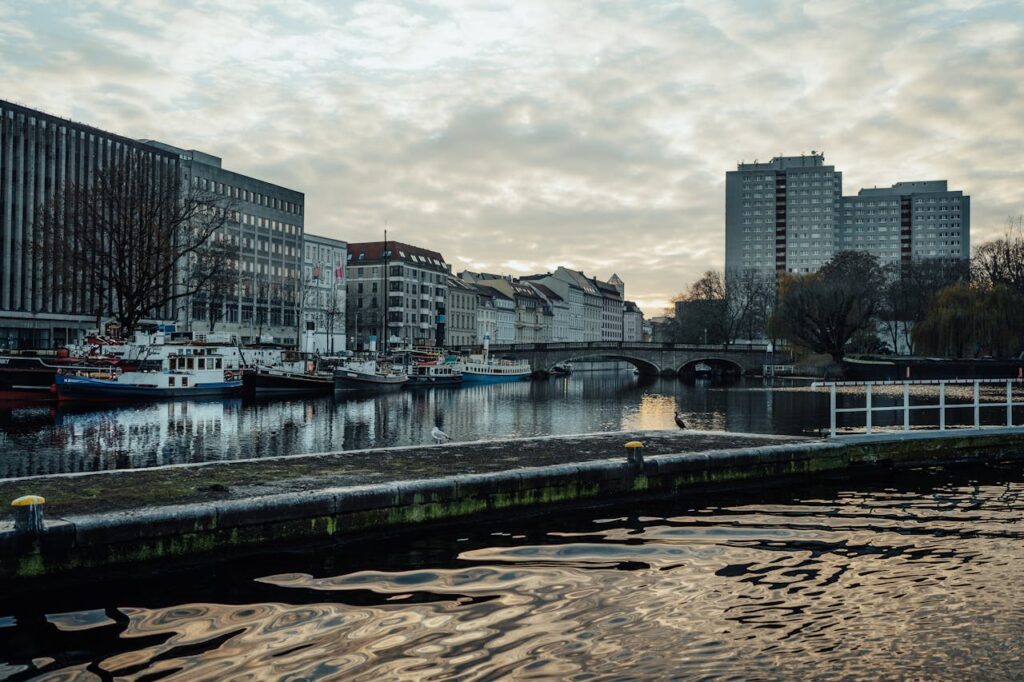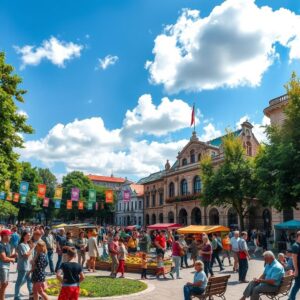
Explore & Play
Discover interesting topics and solve the accompanying crossword puzzle.
German River Crossword | Germany’s major rivers
Table of Contents
At the start of this post, we have a fun challenge for you: the German river crossword. Feel free to test your knowledge of Germany’s rivers first and then read the article for additional insights, or if you’re not as familiar with the topic, you can dive into the article first and return to the crossword later to see how much you’ve learned! Either way, enjoy the journey of discovering the rivers that shape Germany.
German River Crossword
You can either fill in the crossword puzzle directly on this page or click the button in the bottom right corner to print it for free.

A Tour of Germany’s Major Rivers and Tributaries
Germany’s rivers have shaped the country’s landscape, economy, and culture for centuries. Waterways like the Rhine, Elbe, and Danube serve as vital arteries for trade, travel, and life itself. As you journey through Germany’s river systems, from the towering mountains to the fertile plains, you’ll witness their profound influence on everything from the growth of ancient cities to the development of agriculture, transport, and industry. The rivers don’t just offer scenic beauty but also provide a deep connection to the heart of German heritage.
In this article, we’ll explore the most important rivers of Germany, focusing not only on the major players like the Rhine and Danube, but also on their lesser-known tributaries, including the Oder, Weser, and Havel. Along the way, we’ll dive into the historical, cultural, and ecological impact of these rivers, while also providing a fun crossword puzzle challenge at the end for you to test your knowledge of these iconic waterways.
1. The Elbe River: Germany’s Historical and Economic Heart
1.1 The Course of the Elbe: From the Czech Republic to the North Sea
The Elbe is one of Germany’s longest and most significant rivers, flowing for over 1,000 kilometers across Central Europe. It begins in the Czech Republic in the Bohemian Mountains, winding its way through Germany and into the North Sea. Along its path, the Elbe passes through major cities such as Dresden and Hamburg, two urban centers that owe much of their growth and prosperity to the river. Historically, the Elbe served as a critical trade route, linking Germany to the rest of Europe. Its strategic location also made it an essential part of military operations throughout history, including during the Thirty Years’ War and both World Wars.
1.2 The Elbe’s Tributaries: Connecting Regions and Communities
The Elbe’s tributaries, like the Havel and Saale, play a vital role in enhancing its reach and the diverse communities along its banks. The Havel, which flows into the Elbe near Berlin, connects northern Germany to the vast network of rivers that feed into the Baltic Sea. The Saale, flowing from Thuringia, adds to the Elbe‘s importance as it traverses the heart of Germany, fostering connections between the east and west.
Each tributary contributes to the rich ecological diversity of the Elbe, creating a network of freshwater ecosystems that support a wide range of species, from migratory birds to native fish. The convergence of these rivers has not only shaped the geography but also the development of the communities they pass through.
2. The Rhine: A River of Legend and Commerce
2.1 The Rhine’s Role in German History and Trade
The Rhine is arguably the most iconic river in Germany, and its influence cannot be overstated. It originates in the Swiss Alps and flows through Germany, the Netherlands, and into the North Sea. The Rhine is often seen as a symbol of German identity, immortalized in mythology, art, and literature. For centuries, it has served as a major trade route, supporting commerce and connecting Germany to the broader European continent.
The river has played a central role in Germany’s industrialization, particularly during the 19th century. Cities like Cologne, Düsseldorf, and Mainz became thriving hubs of commerce, spurred by their strategic locations along the Rhine. This river’s role in trade extends beyond just goods; it has also been a conduit for cultural exchange, influencing everything from architecture to cuisine.
2.2 The Rhine’s Tributaries: Flowing Through Regions of Distinction
The Rhine’s tributaries, including the Main and the Weser, significantly contribute to its importance as a transportation route. The Main, for example, flows through Frankfurt, Germany’s financial capital, and links the Rhine to the central regions of the country. The Weser meanders through Lower Saxony, creating vital connections for both local industries and agricultural communities.
These tributaries don’t just enhance the economic value of the Rhine, but they also enrich the river’s cultural diversity, each tributary carrying its own traditions and regional specialties that have been shaped by centuries of flowing water.
3. The Danube: Europe’s Grand Waterway
3.1 The Danube’s Journey: From the Black Forest to the Black Sea
The Danube is Europe’s second-longest river, flowing through ten countries from its source in the Black Forest of Germany to its mouth on the Black Sea. This river has had a significant impact on the development of European civilization, and its German section is no less remarkable. The Danube flows through cities such as Ulm and Passau, each with a history closely tied to the river.
Unlike the Rhine, which primarily serves Germany’s western regions, the Danube cuts through the southern parts of the country, connecting Germany to Austria, Hungary, and beyond. Its role in trade and travel dates back to ancient Roman times when it served as the northern border of the Roman Empire.
3.2 The Danube’s Tributaries: Vital to Germany’s Heartland
The Danube’s tributaries, such as the Inn and Neckar, feed into this grand waterway, enhancing its importance in regional trade. The Neckar, flowing from the Swabian Alps, meets the Danube in the city of Ulm, further enriching its role as a trade route between Germany and Austria. The Inn, which flows from Switzerland into Germany, is another vital contributor to the Danube‘s ecosystem and economic network.
These tributaries help distribute water to the fertile plains of southern Germany, where agriculture thrives, and also create new pathways for commerce that help to shape the region’s economy.
4. The Oder: Germany’s Eastern Boundary
4.1 The Oder’s Flow and Its Economic Role
The Oder river forms part of Germany’s eastern boundary with Poland, making it a river of geopolitical significance. It flows from the Czech Republic, traversing northeastern Germany, before emptying into the Baltic Sea. Cities like Frankfurt (Oder) on the river’s western bank have long relied on the Oder for trade, fishing, and transportation. The river has historically been a strategic point of control, especially during periods of conflict.
Economically, the Oder has played an essential role in facilitating the flow of goods between Germany and Poland, particularly after the reunification of Germany. The river is crucial for transporting coal and other raw materials from the industrial heartlands of Silesia to the ports of the Baltic Sea.
4.2 The Oder’s Tributaries: Adding Depth to the Flow
Smaller rivers like the Neisse flow into the Oder, forming an intricate network of waterways that have nurtured both the surrounding ecosystems and the local communities. These tributaries ensure that the Oder remains an essential transport and trade route, while also supporting a rich variety of flora and fauna along its course.
5. The Weser: A Lifeline of Northern Germany
5.1 The Significance of the Weser to North Germany
The Weser is a major river in northern Germany, running exclusively through the country. It flows from the Weser Uplands and empties into the North Sea. The Weser connects key cities such as Bremen and Minden, which have relied on the river for centuries for trade and transport. As one of the longest rivers in the region, the Weser is a lifeline for both the local economy and communities.
The river also plays a crucial role in agriculture, especially for the regions of Lower Saxony and North Rhine-Westphalia, where fertile lands along the Weser have allowed for the cultivation of a wide variety of crops.
5.2 Tributaries of the Weser: A Network of Rivers
The Werrra and Ems are two important tributaries of the Weser, contributing significantly to the river’s flow and the economy of the region. The Ems, in particular, is known for its vital role in connecting the Weser to the North Sea through the port of Emden. These tributaries have helped establish the Weser as an important trade route for goods flowing to and from the northern regions of Germany.
6. The Small Rivers of Germany: Hidden Gems in the Landscape
6.1 The Oderbruch: A Historical Region Shaped by Water
The Oderbruch is a unique region formed by the Oder river, known for its rich history and agricultural significance. This swampy, low-lying land area has been carefully cultivated over centuries, turning into some of the most productive farmland in Germany. The Oderbruch has also been the site of major engineering projects aimed at controlling the river’s flow to prevent flooding while maintaining fertile soil for farming.
6.2 Rivers like the Wupper, Jagst, and Zschopau: The Smaller Yet Mighty Tributaries
Rivers such as the Wupper, Jagst, and Zschopau are smaller tributaries that may not have the fame of the Rhine or Danube, but they contribute significantly to the river systems of Germany. These rivers are often overlooked but are essential in their local contexts, supporting smaller communities, agriculture, and wildlife.
Exploring the Rivers of Germany: A Call to Action
Germany’s rivers offer more than just scenic views and natural beauty; they are integral to the country’s economic, cultural, and environmental fabric. Whether you’re interested in the bustling trade routes of the Rhine, the historical legacy of the Elbe, or the far-reaching course of the Danube, these waterways tell the story of Germany’s past, present, and future.
Ready to test your knowledge of these iconic rivers? Dive into our crossword puzzle and challenge yourself to discover more about Germany’s rivers!
Share to...
I hope you enjoy the content.
Want to receive our daily crossword puzzle or article? Subscribe!
You may also be interested in
Share to…
Want to receive our daily crossword puzzle?
-
Jigsaw Puzzles
Twelve Zodiac Cow Ink Wash Jigsaw Puzzle 250 | 300 | 500 Pieces
kr 348,00 – kr 439,00Price range: kr 348,00 through kr 439,00 Select options This product has multiple variants. The options may be chosen on the product page -
Jigsaw Puzzles
Zodiac Ink Art Puzzle: The Playful Monkey 250 | 300 | 500 Pieces
kr 348,00 – kr 439,00Price range: kr 348,00 through kr 439,00 Select options This product has multiple variants. The options may be chosen on the product page -
Jigsaw Puzzles
Majestic Horse Watercolor Jigsaw Puzzle 250 | 300 | 500 Pieces
kr 348,00 – kr 439,00Price range: kr 348,00 through kr 439,00 Select options This product has multiple variants. The options may be chosen on the product page

















